
Lighthouses guide ships for 160 years
SAN JUAN, P.R.— Overlooking the steep north coast of Puerto Rico, 181 feet above the sea and, on a clear night, projecting its powerful beacon 24 miles northward into the Atlantic Ocean, El Morro Light has been guiding ships into San Juan Bay for more than 160 years.
Officially known as “Puerto San Juan Light” in U.S. Coast Guard publications, the light’s moniker comes because it sits atop Fuerte San Felipe del Morro, the vast Spanish fortress that has protected San Juan’s harbor since colonial times.
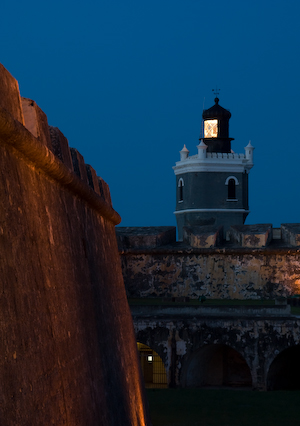 |
Sitting atop El Morro Castle, the Puerto San Juan light is visible 24 miles at sea on a clear night (Photo by Vincent Daniello). |
The current light is the third constructed atop the fort. The first proper lighthouse was built by the Spanish in 1846.
“The first [lighthouse] was built on a different part of the fort. The Spanish moved that tower to where it is today,” said Carlos Almodóvar, a San Juan National Historic Site ranger and interpreter and an expert on the park’s history.
A large circle in the stonework of the fort marks the original location of the light, on the same upper level as the current light, but further from the Atlantic Ocean, near the southwest corner of that level of the fort.
In the 1870s, a replacement tower was built, according to Almodóvar, which was damaged during the Spanish-American War in 1898 by the United States’ naval bombardment.
The damaged light was replaced by the U.S. government in 1899. This first American-built lighthouse had to be replaced when, after just six years, the tower developed structural cracks that made it unsafe. The current brick and masonry tower was first lighted in 1908 and has been operational since.
| The current tower is the third built atop the fort, completed in 1908 (Photo by Vincent Daniello). |
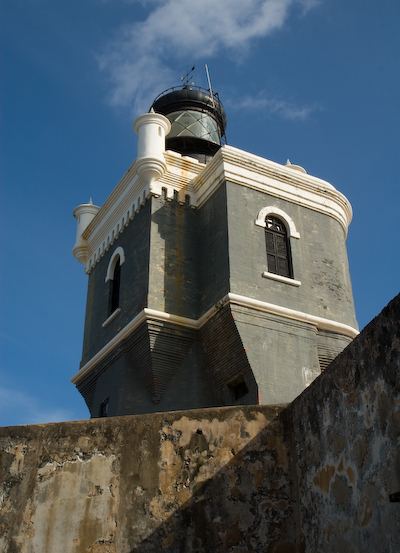 |
San Juan is the second oldest European-settled city in the Western Hemisphere. Discovered by Christopher Columbus on his second voyage in 1493 and settled by Juan Ponce de León in 1508, only Santo Domingo, in the Dominican Republic, preceded it.
As the first major island that sailors reached when arriving to the New World on the voyage from Spain, San Juan became the most important port and defensive fortification in the region.
So why did the Spanish wait nearly a quarter of a millennium, until 1846, to build a lighthouse here? Part of that answer may be the technology available through this time. In fact, the first lighthouse, in 1846, likely wasn’t the first beacon to guide ships.
“Before that, there might have been a brazier on a post, or perhaps an open fire. That was the typical progression before a light was built.” said Chad Kaiser, the historian and librarian for the United States Lighthouse Society, a 12,000-member organization that funds lighthouse restoration and museums and conducts tours of historic lighthouses worldwide.
Even into the 19th Century, lighthouses were inefficient—typically only visible for a few miles. They were often used to warn ships of dangerous reefs or underwater hazards in the immediate vicinity of the light. The coast of San Juan has no such dangers. In fact the Puerto Rico trench, just north of the island, is the deepest point in the Atlantic Ocean, so there was little need for such a “keep-away marker.”
Lighthouse technology improved before the work of Augustin-Jean Fresnel (pronounced Frey-nel), but his lens offered far more than just an increase in output. It was much more efficient.
“Fresnel made his lens in 1822. Before then, lighthouse builders primarily used reflectors, 16 was a typical number,” Kaiser said. “Each would have a burner, burning whale oil or whatever the light used. The Fresnel lens would use only one burner. Over time, this saved a lot [of money].”
Because it concentrates light so effectively, Fresnel’s lens design is still in use today, not only in lighthouses, but also in traffic lights, movie and television studio lighting, aircraft carrier landing light systems and even automobile tail lights.
A Fresnel lens is actually a number of small lenses set into a framework in a circular pattern. In the largest lighthouse lenses, more than 1,000 individual lenses might be used. Each lens is angled precisely so that it takes the incoming light from a lighthouse’s bulb or kerosene lamp and bends the light rays, making each of the individual lenses project their beams exactly toward the same distant point on the horizon.
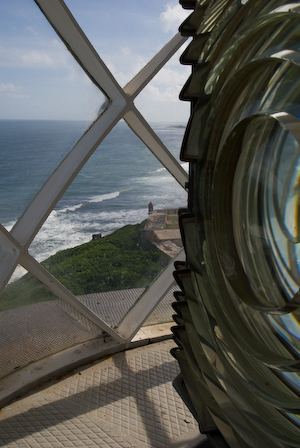 |
A “Fresnel Lens” is actually a number of lenses, each angled very precisely to focus the lighthouse’s light source into a concentrated beam (Photo by Vincent Daniello). |
This precisely focused beam greatly increases a lighthouse’s range. Since the light could be seen much farther out at sea, lighthouses became valuable for guiding ships toward a harbor.
There were seven classifications of lights in all, the brightest first order lens measured about 10 feet tall and 6 feet in diameter, and weighed three tons. To accommodate the sharp angles the light rays must be bent at the top and bottom of a first-order light, the upper and lower sections did not simply bend the light, but rather reflected the incoming light off the back of the lens and then projected it outward precisely toward the horizon.
To distinguish them from other lights ashore, lighthouses like this San Juan light were made to flash their beacons. To do this, several Fresnel lenses were installed into a circular frame that was made to rotate around the light. As the center focal point of each lens rotated through a spot on the horizon, the light would appear as a bright, momentary flash.
San Juan Light’s current lens is the Fresnel lens installed by the U.S. when this light was commissioned in 1908. Built by Sautter, Lemonnier & Cie in Paris, this third-order lens, roughly three feet in diameter and three feet tall, rotates every 40 seconds. With its original kerosene light, it was visible to ships about 18 miles away.
| A total of 181 feet above the Atlantic, El Morro light can be easily identified by day or by night (Photo by Vincent Daniello). |
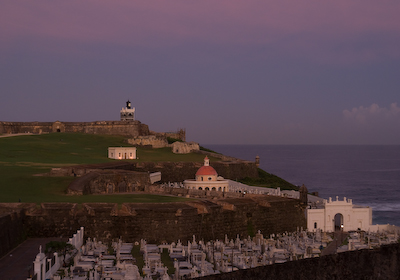 |
Lighthouses of that time typically rotated on a system of small brass wheels, called chariot wheels, riding on a steel track, according to Kaiser.
“Later, these wheels might have been changed to ball bearings,” Kaiser said. “In ’08, it might have even been installed with ball bearings originally.”
Records were clearer on the 1908 clockwork assembly. The light was made to rotate by a system of gears driven by a 200-pound weight suspended on a steel cable. The weight was wound onto a drum and then allowed to fall slowly down a tube in the center of the lighthouse, its weight thereby powering the lens rotation much like the mechanism of an old-fashioned grandfather clock.
Larger, heavier lenses often floated on a bed of mercury— which creates an extremely low-friction bearing— instead of chariot wheels or ball bearings.
“Typically these mechanisms had to be wound [with a hand crank] every four to six hours,” Kaiser explained. “The lamps, especially, needed to be tended, so they didn’t want the lighthouse keepers to be able to wind the light and leave it. They never wanted it to be unattended too long.”
The light itself is an incandescent oil vapor light. Like a giant Coleman lantern, a tank was partially filled with kerosene and then pressurized with air from a hand pump. This pressurized fuel was then run through a circular silk mantle.
“They used to coat that mantle, like a little silk sock, with thorium oxide, a radioactive substance” Kaiser said. “It would resist the high temperatures. The thorium would incandesce when lit and not burn away, and it allowed them to reuse the mantle.”
El Morro light was electrified in 1932—both with an electric light bulb and also a motor to rotate the Fresnel lens assembly. The light was fully automated by the U.S. Coast Guard in 1962.
 |
The “Fresnel Lens” (Photo by Vincent Daniello). |
El Morro light does not look like a typical lighthouse. The light’s horseshoe-shaped trim above the windows, square fretwork along the top of the brick structure, and onion-shaped minarets rising above the fretwork and on the light itself, are of Moorish Revival architecture, popular in the U.S. in the mid-19th Century, although waning by the time this light was built early in the 20th Century.
“This light, the style, is fairly unique,” said Kaiser. “I don’t know of another light built in with that architecture.”
While the light’s designer may have simply been trying to find something in keeping with the Spanish architecture of El Morro and also appropriate to place atop a fort, there is a much deeper historic connection between the Moorish architecture and lighthouses that a clever architect may have seized upon.
Minarets have become a symbol of Muslim mosques. They are traditionally the place from which faithful are called to prayer. But they take their design from ancient lighthouses. In fact, the word means lighthouse in Arabic.
| While it is unusual, the lighthouse’s Moorish Revival architecture, with its minarets, is in keeping with ancient lighthouse designs (Photo by Vincent Daniello). |
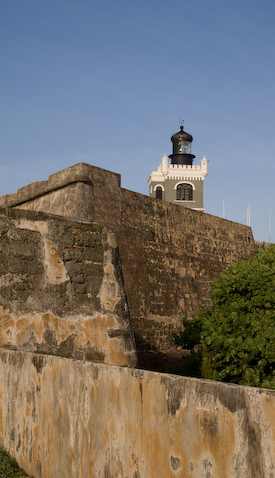 |
Today, the light is somewhat rundown. The paint is peeling. Window shutters are broken and there are plywood patches over missing glass panes. The lighthouse was renovated roughly 15 years ago and a thorough restoration is likely in the near future.
“The lighthouse sits at the highest point on the fort,” Almodóvar said. “There it is most vulnerable to wind and rain and salt from the sea. This takes its toll.”
Still an important navigational aid, El Morro Light is number 30735 in the Coast Guard’s Light List that ship captains use to find details of aids to navigation. To positively identify a light even when far at sea, each light is given a unique “characteristic” or pattern of flashes.
El Morro light, according to the Light List, flashes three times every 40 seconds. The first and second flashes occur 8.7 seconds apart, the final flash 18.7 seconds later. (To accommodate this, the gaps between the Fresnel lenses that create the flashes are filled with plywood panels.)
| Fifteen years since its last renovation and constantly exposed to the elements, the light is in need of restoration (Photo by Vincent Daniello). |
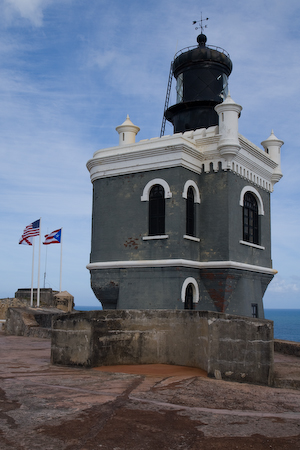 |
The light is also obscured from the east through the south and back to the west so it can only be seen from sea, where it still guides mariners safely into the harbor and it likely will continue to do so for many years to come.
If You Go
- El Morro fortress is readily accessed by the public and is open daily from 9 a.m. to 5 p.m. from June through November and 9 a.m. to 6 p.m. in the winter months. San Juan National Historic Site rangers collect the $3 fee when entering the fort (the fee is $5 for both forts and children under 15 years old are admitted free).
- A free tram, provided by the historic site, runs between the two forts and the cruise ship terminal approximately every 20 minutes.
- The Puerto San Juan Lighthouse is still a working navigational aid. Unfortunately, because of the importance of this light and the fragile nature of the ultra-clear glass used in turn-of-the-century lighthouse lenses, the lighthouse doors are locked with no public access inside the light. Park rangers and interpreters at the fort are available to answer questions in both English and Spanish.
United States Lighthouse Society
For more information about lighthouses, or to become involved in their preservation or to join in tours of historic lighthouses around the world, visit the website of the United States Lighthouse Society. (www.uslhs.org)

Comments are Closed